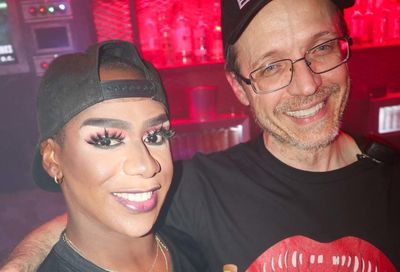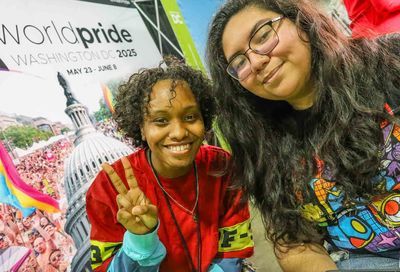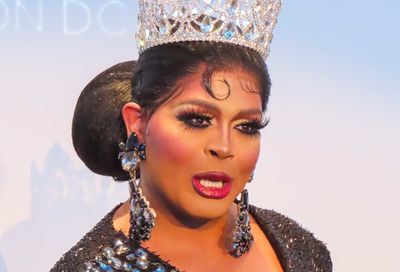Night of Kings
Learning Curve
On March 5th, D.C.’s monthly Drag King Night at Chaos celebrated its three-year anniversary. “This is the world’s longest-running drag king show, ” organizer and emcee Ken Las Vegas (Kendra Kuliga) solemnly informed a full house of screaming fans. “Over sixty kings have participated on this stage; forty are still active here in D.C. We’re so glad you keep coming back and aren’t, you know, all kinged out. We even had the management build us a higher stage… ”
Right on cue, the club’s manager shouted, “We had to, because you guys don’t wear heels! ”
Backstage, warming up the assembled kings with an anniversary speech and a squeeze passed from hand to hand, Ken thanked longtime local activist Cheryl Spector, who helped bring drag king culture to D.C. after seeing similar shows in New York. The initial gamble really paid off, much to the mutual delight of performers and audience who keep this daring genre a staple of D.C. lesbian nightlife. Gender-bending humor is part of Ken’s homage to Drag King Night’s unexpected success–“This show wasn’t something we thought we could guarantee would happen every month, like my period, “– a gentle reminder that yeah, these guys are gals, but on show night they’re known by the “he ” of their stage names: Maestro, Nicholas, Johnny Kat, Ceasar Melons.
When I go out on the first Wednesday of every month to cheer a drag king show, I’m paying feminist money to pump love and admiration for boy-looking girls. These performers, who as young dykes on the street often endure the lion’s share of homophobic taunts, turn that gender-baiting around and embrace the stud within by expertly applying stage facial hair and a kick-ass persona and soundtrack. I once cross-dressed as a Halloween-costumed boy athlete back in high school, but what I know about packing and personification is two rungs below dabbler: these kings have style, swagger, politics and pride. To which I say, hail, sister, and raise my frosted glass.
|
On Drag King Night the stage is ringed with appreciative young women, some in fake mustachios and fedoras. Their white shirtfronts glow in the recessed blacklight tubing, radiant, teeth and cotton sleeves radiant, perfect. The blacklight effect makes me think of my 1970s bedroom, and now my open journal page is blinding white, UFO-like, and we’re all in this joyful spaceship together, waiting for the revue to begin. I lean on the little half-moon bar with its big pillar, perfect for show-watching if you like to slap your bar journal down and jot notes, and across the way my counterpart in drag king anthropology, Joy Sapinoso from the University of Maryland, waves back. No one even notices us writing any more; we’re part of the backdrop, trusted.
And now it begins. The kings amble onstage, dressed as Elvis, sailor, schoolboy, pimp, Eminem, gangster, leatherdaddy, garage mechanic. They toss handfuls of cherry Blow-pops and chocolate Tootsie Pops into the audience. I’m flattered when Ken Las Vegas throws a treat to me, the treat that bridges generations: we all found girlhood happiness in a red Tootsie Pop, and now the circle around the stage is packed with young dyke faces, each tonguing a Tootsie Pop; me too. I, too, want to lick my way to the center of the earth, if the world is layer after layer of dyke, and sweetness fills our mouths, our minds, our open waiting hearts. During the first act all the girls in white glowing shirtsleeves have lips and tongues coated cherry red, the dreamy, focused faces of femme women watching drag kings go to work.
On drag king night the line-up features anywhere from six to ten acts, with fans throwing dollars onto the stage or waving them coyly at a favorite king. There are white, black, Asian, Latina and Jewish kings, each with a following. I’ve seen drag king performances at Chaos take on increasingly political tones, maturing beyond homegrown entertainment to tackle hard questions about wartime, gender resistance, body presentation.
At a show commemorating the September 11th attacks, one performance featured a robed figure kneeling before candles of grief and mourning. After genuflecting solemnly, the drag king threw off his robes to reveal a Pentagon uniform — with red, white and blue feathers in the pockets. This too was removed to reveal an eagle on a breast-bound chest. In that same show, to the throbbing sounds of “War: What is it Good For? “, a king dressed in officer uniform kicked and pretended to beat a younger king “burning ” a draft card. This scene was hard to watch because of its simulated violence, but its genius lay in transitions: the peace protestor removed his stoner t-shirt to reveal an army uniform and began to scrub the floor and lick the boots of the abusive officer.
Ultimately, both kings sank to the stage floor and simulated gay male sex, then pulled off a final layer of clothes to reveal two t-shirts: DON’T ASK, DON’T TELL and MAKE LOVE, NOT WAR. On that night I wrote in my bar journal, “This is going to be big. Pay attention now. Get to know and love these artists now. This is quality stuff. ” Next to me stood Ken’s own mother, tenderly videotaping Ken’s antics onstage, fully packed dildo and all. Having a supportive mom in the audience made us all puff with pride.
As a women’s studies professor I’ve had many tense conversations about both drag king and drag queen culture, transgender issues, and whether a king show advertised as “Big Pimp Nite! ” is feminist. Some of the transformative masculinity is surely a pepper flake in the eye of conservative critics: bad dykes, sick girls, why the need to fetishize? Of course, the world’s most traditional men wear dresses: Supreme Court justices, the Pope. Their costuming is power.
For women long denied male power, approximating it is wicked fun, or, more seriously, the permitted emergence of a persona felt since grade school. After two decades spent attending women’s music festivals, I know good entertainment from bad; and here in wartime-weary D.C. I’m also a girl in the ‘hood glad to find some respite. Yes, there is a place to go with happy, uplifted faces screaming “more, ” where we’re all passengers on the good ship Lesbos.
Bonnie J. Morris, Ph.D., is on the women’s studies faculty at George Washington University and Georgetown University. She can be reached at bmorris@metroweekly.com.
Support Metro Weekly’s Journalism
These are challenging times for news organizations. And yet it’s crucial we stay active and provide vital resources and information to both our local readers and the world. So won’t you please take a moment and consider supporting Metro Weekly with a membership? For as little as $5 a month, you can help ensure Metro Weekly magazine and MetroWeekly.com remain free, viable resources as we provide the best, most diverse, culturally-resonant LGBTQ coverage in both the D.C. region and around the world. Memberships come with exclusive perks and discounts, your own personal digital delivery of each week’s magazine (and an archive), access to our Member's Lounge when it launches this fall, and exclusive members-only items like Metro Weekly Membership Mugs and Tote Bags! Check out all our membership levels here and please join us today!



















